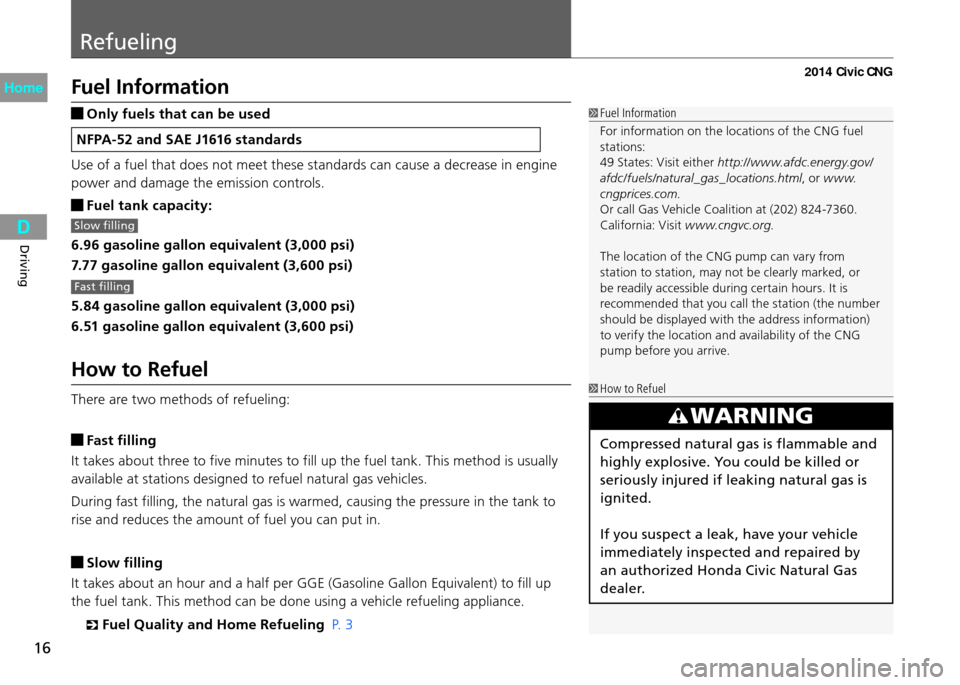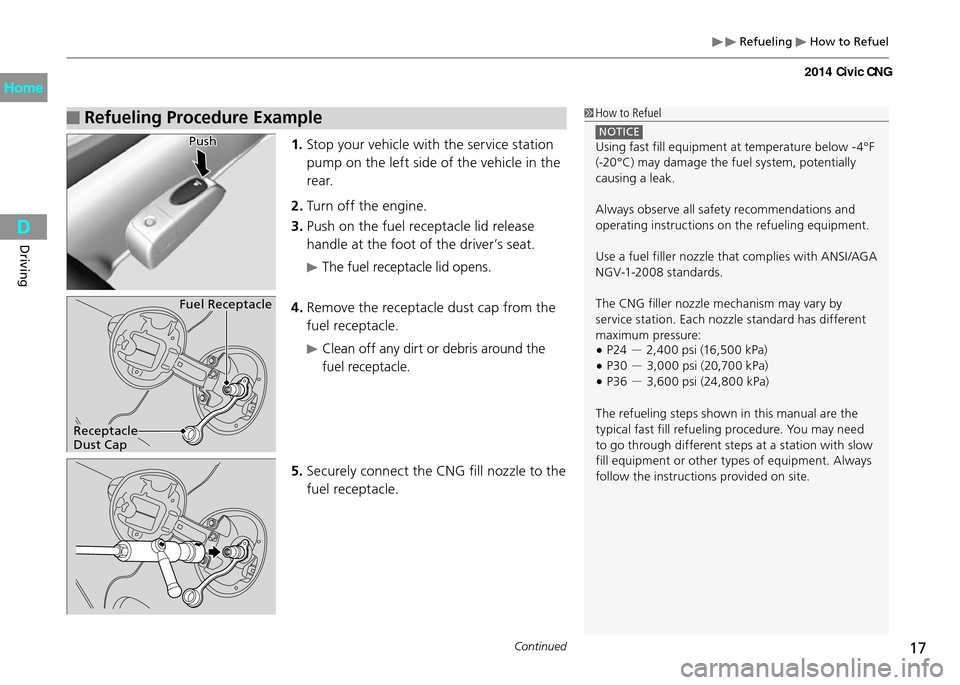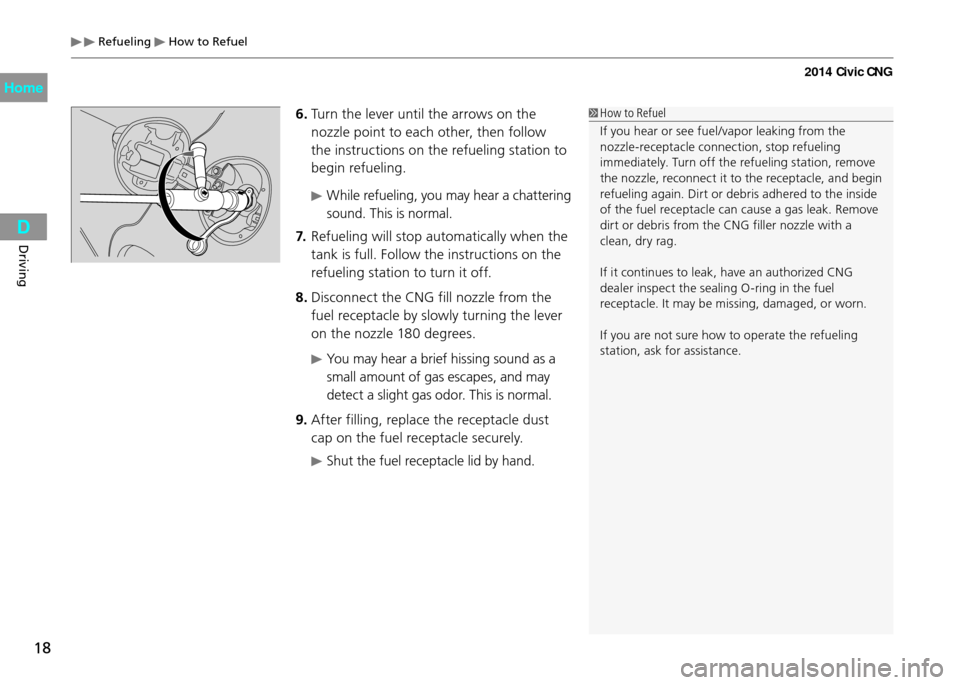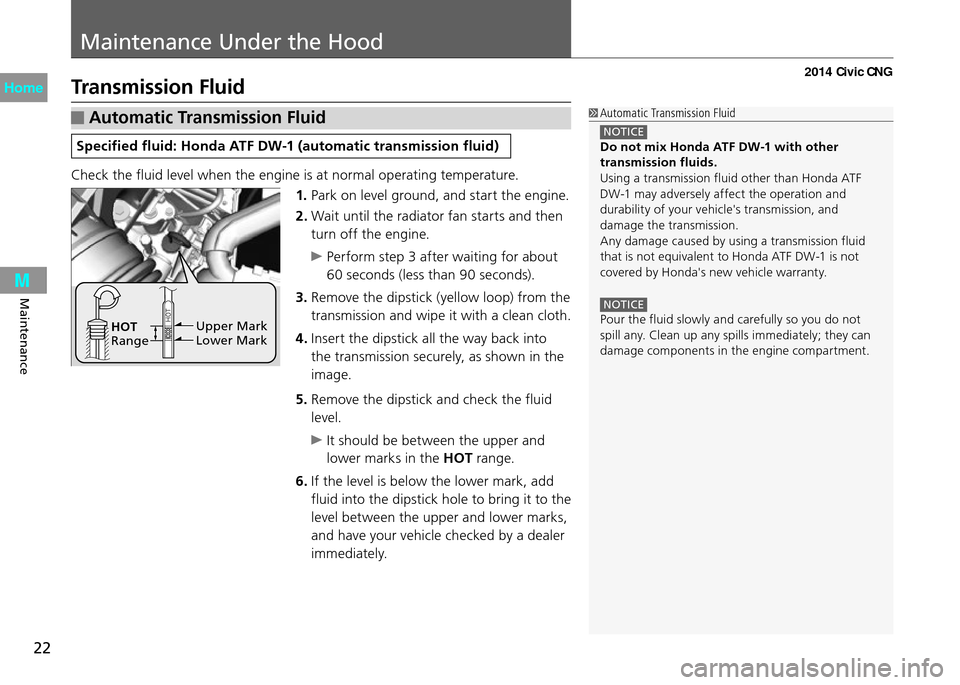Page 17 of 46

Refueling
16
Driving
Fuel Information
Only fuels that can be used
NFPA-52 and SAE J1616 standards
Use of a fuel that does not meet these standards can cause a decrease in engine
power and damage the emission controls.
Fuel tank capacity:
Slow filling
6.96 gasoline gallon equivalent (3,000 psi)
7.77 gasoline gallon equivalent (3,600 psi)
Fast filling
5.84 gasoline gallon equivalent (3,000 psi)
6.51 gasoline gallon equivalent (3,600 psi)
How to Refuel
There are two methods of refueling:
Fast filling
It takes about three to five minutes to fill up the fuel tank. This method is usually
available at stations designed to refuel natural gas vehicles.
During fast filling, the natural gas is warmed, causing the pressure in the tank to
rise and reduces the amount of fuel you can put in.
Slow filling
It takes about an hour and a half per GGE (Gasoline Gallon Equivalent) to fill up
the fuel tank. This method can be done using a vehicle refueling appliance.
Fuel Quality and Home Refuelin g
P. 3
Fuel Information
For information on the locations of the CNG fuel
stations:
49 States: Visit either http://w w w.afdc.energy.gov/
afdc/fuels/natural_gas_ locations.html , or www.
cngprices.com.
Or call Gas Vehicle Coalition at (202) 824-7360.
California: Visit www.cngvc.org.
The location of the CNG pump can vary from
station to station, may not be clearly marked, or
be readily accessible during certain hours. It is
recommended that you call the station (the number
should be displayed with the address information)
to verify the location and availability of the CNG
pump before you arrive.
How to Refuel
WARNING
Compressed natural gas is flammable and
highly explosive. You could be killed or
seriously injured if leaking natural gas is
ignited.
If you suspect a leak, have your vehicle
immediately inspected and repaired by
an authorized Honda Civic Natural Gas
d e a l e r.
2014 Civic CNG
Page 18 of 46

Refueling How to Refuel
17Continued
Driving
Refueling Procedure Example How to Refuel
NOTICE Using fast fill equipment at temperature below -4°F
(-20°C) may damage the fuel system, potentially
causing a leak.
Always observe all safety recommendations and
operating instructions on the refueling equipment.
Use a fuel filler nozzle that complies with ANSI/AGA
NGV-1-2008 standards.
The CNG filler nozzle mechanism may vary by
service station. Each nozzle standard has different
maximum pressure:P24
•- 2,400 psi (16,500 kPa)
P30
•- 3,000 psi (20,700 kPa)
P36
•- 3,600 psi (24,800 kPa)
The refueling steps shown in this manual are the
typical fast fill refueling procedure. You may need
to go through different steps at a station with slow
fill equipment or other types of equipment. Always
follow the instructions provided on site.
1. Stop your vehicle with the service station
pump on the left side of the vehicle in the
r e a r.
2. Turn off the engine.
3. Push on the fuel receptacle lid release
handle at the foot of the driver’s seat.
The fuel receptacle lid opens.
4. Remove the receptacle dust cap from the
fuel receptacle.
Clean off any dirt or debris around the
fuel receptacle.
5
. Securely connect the CNG fill nozzle to the
fuel receptacle.
Push
Fuel Receptacle
Receptacle
Dust Cap
2014 Civic CNG
Page 19 of 46

Refueling How to Refuel
18
Driving
How to Refuel
If you hear or see fuel/vapor leaking from the
nozzle-receptacle connection, stop refueling
immediately. Turn off the refueling station, remove
the nozzle, reconnect it to the receptacle, and begin
refueling again. Dirt or debris adhered to the inside
of the fuel receptacle can cause a gas leak. Remove
dirt or debris from the CNG filler nozzle with a
clean, dry rag.
If it continues to leak, have an authorized CNG
dealer inspect the sealing O-ring in the fuel
receptacle. It may be missing, damaged, or worn.
If you are not sure how to operate the refueling
station, ask for assistance.6. Turn the lever until the arrows on the
nozzle point to each other, then follow
the instructions on the refueling station to
begin refueling.
While refueling, you may hear a chattering
sound. This is normal.
7. Refueling will stop automatically when the
tank is full. Follow the instructions on the
refueling station to turn it off.
8. Disconnect the CNG fill nozzle from the
fuel receptacle by slowly turning the lever
on the nozzle 180 degrees.
You may hear a brief hissing sound as a
small amount of gas escapes, and may
detect a slight gas odor. This is normal.
9. After filling, replace the receptacle dust
cap on the fuel receptacle securely.
Shut the fuel receptacle lid by hand.
2014 Civic CNG
Page 20 of 46
19
Maintaining the Fuel System
Maintenance
Your vehicle’s fuel system must be maintained and repaired by an authorized Civic
Natural Gas dealer or a certified NGV technician. The fuel system has no user-
serviceable parts, and its components must not be modified.
See instructions on fuel container for inspection and service life.
Maintaining the Fuel System
Service Pressure: 3,600 psi (24,800 kPa)
CNG Label Locations
P. 4
WARNING
Tampering with, or improperly
maintaining the high-pressure fuel system
can cause a dangerous condition in which
you can be seriously hurt or killed.
Never attempt to modify the fuel system,
and always have fuel system maintenance
performed by an authorized Honda Civic
Natural Gas dealer, or a qualified NGV
technician.
Indoor Vehicle Storage
If you store your vehicle indoors, make sure there is adequate ventilation. We
recommend that you also install a natural gas leak detector.
2014 Civic CNG
Page 21 of 46
20
Maintenance
Maintenance MinderTM
Your vehicle displays engine oil life and maintenance service items on the
intelligent multi-information display (i-MID) to show you when you should have a
dealer do engine oil replacement and indicated maintenance service.
Refer to the important safety precautions and instructions in the Owner's Manual.
2014 Civic CNG
Page 22 of 46

21
Maintenance
Maintenance MinderTM To Use Maintenace MinderTM
Maintenance Service Items
2345
Maintenance Service ItemsIndependent of the Maintenance Minder
•information, replace the brake fluid every 3 years.
Inspect idle speed every 160,000 miles (256,000
•km).
Adjust the valves during services A, B, 1, 2, or 3 if
•they are noisy.
CODE Maintenance Main Items
A Replace engine oil •
*1
B Replace engine oil• *1 and oil filter
Replace fuel filter element (low pressure)
•
Drain fuel filter (high pressure)
•
Inspect front and rear brakes/service as necessary
•
Check parking brake adjustment
•
Inspect tie rod ends, steering gearbox, and boots
•
Inspect suspension components
•
Inspect driveshaft boots
•
Inspect brake hoses and lines (Including ABS/ VSA)
•
Inspect all fluid levels and condition of fluids
•
Inspect exhaust system
• #
Inspect fuel lines and connections
• #
Check the expiration date for TRK bottle
• *2
CODE Maintenance Sub Items
1 Rotate tires •
2 Replace air cleaner element• *3
Replace dust and pollen filter
• *4
Replace fuel filter element (high pressure)
•
Inspect drive belt
•
Inspect valve clearance
•
Inspect fuel tank
• *5
3 Replace transmission fluid •
4 Replace spark plugs•
5 Replace engine coolant•
*1: If a message SERVICE does not appear more than 12 months after the display is reset, change the
engine oil every year.
*2: Models with tire repair kit
# : See information on maintenance and emissions warranty. *3: If you drive in dusty conditions, replace the air cleaner element every 15,000 miles (24,000 km).
*4: If you drive primarily in urban areas that have high concentrations of soot in the air from industry and
from diesel-powered vehicles, replace the dust and pollen filter every 15,000 miles (24,000 km).
*5: If sub item 2 does not appear more than 36 months after the display is reset, inspect the fuel tank
every three years.
See CNG tank expiration and production dates on page 5 for inspection and replacement
information. Fuel tank should be replaced 15 years after it was manufactured.
System Message
Indicator
Maintenance Minder
Message
Main
Item Sub Items
2014 Civic CNG
Page 23 of 46

Maintenance Under the Hood
22
Maintenance
Transmission Fluid
Automatic Transmission Fluid
Specified fluid: Honda ATF DW-1 (automatic transmission fluid)
Check the fluid level when the engine is at normal operating temperature.
HOT
Range Upper Mark
Lower Mark
1.
Park on level ground, and start the engine.
2. Wait until the radiator fan starts and then
turn off the engine.
Perform step 3 after waiting for about
60 seconds (less than 90 seconds).
3. Remove the dipstick (yellow loop) from the
transmission and wipe it with a clean cloth.
4. Insert the dipstick all the way back into
the transmission securely, as shown in the
image.
5. Remove the dipstick and check the fluid
level.
It should be between the upper and
lower marks in the HOT range.
6. If the level is below the lower mark, add
fluid into the dipstick hole to bring it to the
level between the upper and lower marks,
and have your vehicle checked by a dealer
immediately.
Automatic Transmission Fluid
NOTICE Do not mix Honda ATF DW-1 with other
transmission fluids.
Using a transmission fluid other than Honda ATF
DW-1 may adversely affect the operation and
durability of your vehicle's transmission, and
damage the transmission.
Any damage caused by using a transmission fluid
that is not equivalent to Honda ATF DW-1 is not
covered by Honda's new vehicle warranty.
NOTICE Pour the fluid slowly and carefully so you do not
spill any. Clean up any spills immediately; they can
damage components in the engine compartment.
2014 Civic CNG
Page 24 of 46
23
Replacing Light Bulbs
Continued
Maintenance
High-Mount Brake Light Bulb
When replacing, use the following bulb.
High-Mount Brake Light: 21W
1. Open the trunk.
2.
Remove the screw from the center of each
trunk lining fastener, then remove the
fasteners.
3.
Pull the upper edge of the trunk lining
down.
Trunk Lining
Screw
Fastener
2014 Civic CNG